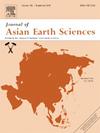U-Pb age and Lu-Hf isotopic compositions of zircon from tuff layers of the late Permian-Early Triassic sedimentary succession in the western Yangtze Block, SW China: Implications for the tectonic evolution and Impact of episodic volcanism on biotic recovery
IF 2.7
3区 地球科学
Q2 GEOSCIENCES, MULTIDISCIPLINARY
引用次数: 0
Abstract
The Zhaotong Basin, located at the southwestern margin of the Yangtze Block, is characterized by multiple layers of sedimentary tuffs. However, the tectonic background of tuffs, the timing of episodic volcanism marked by these tuffs, and the relationship between volcanism and biotic recovery remain controversial. In this study, we integrate petrography with zircon U–Pb and Lu–Hf isotope analyses on five tuff layers bracketing the Permian–Triassic boundary. The zircon U–Pb ages of these tuff layers were determined to be 258.9 ± 0.7 Ma, 254.9 ± 0.6 Ma, 250.0 ± 2.8 Ma, 247.1 ± 1.2 Ma, and 247.2 ± 0.74 Ma. Among these, the age of 247.2 ± 0.74 Ma is proposed as a geochronological marker for the Olenekian–Anisian boundary. Geochemical and Lu–Hf isotope data from the Xuanwei Formation indicate that the earliest tuff layer (258.9 ± 0.7 Ma) originated from acidic volcanism associated with Emeishan basalts. In contrast, the late tuff layer (254.9 ± 0.6 Ma) corresponds to the onset of the closure of the Paleo-Tethys Ocean subduction, with volcanism persisting into the Middle Triassic (247.2 ± 0.74 Ma). Episodic volcanism, as evidenced by the five tuff layers, was temporally coupled with the biocrisis that spanned from the Guadalupian (ca. 260 Ma) to the Anisian (247 Ma). The distinctive εHf(t) values reveal substantial crustal contributions to the magmatic systems throughout the volcanic episodes. These findings indicate that recurrent volcanic activity likely contributed to cyclic environmental perturbations and subsequent delays in biotic recovery spanning > 13 Myr.
扬子地块西部晚二叠世—早三叠世沉积序列凝灰岩锆石U-Pb年龄和Lu-Hf同位素组成:构造演化和幕式火山作用对生物恢复的影响
昭通盆地位于扬子地块西南缘,具有多层凝灰岩的沉积特征。然而,凝灰岩的构造背景、以凝灰岩为标志的幕式火山作用的时间以及火山作用与生物恢复的关系仍存在争议。在本研究中,我们将岩石学与锆石U-Pb和Lu-Hf同位素分析结合起来,分析了覆盖二叠纪-三叠纪边界的5个凝灰岩层。这些凝灰岩的锆石U-Pb年龄分别为258.9±0.7 Ma、254.9±0.6 Ma、250.0±2.8 Ma、247.1±1.2 Ma和247.2±0.74 Ma。其中,247.2±0.74 Ma被认为是奥列涅纪-阿尼西期界线的年代学标志。宣威组地球化学和Lu-Hf同位素资料表明,最早的凝灰岩层(258.9±0.7 Ma)起源于与峨眉山玄武岩相关的酸性火山作用。晚凝灰岩层(254.9±0.6 Ma)对应古特提斯洋俯冲结束的开始,火山活动持续到中三叠世(247.2±0.74 Ma)。从5个凝灰岩层可以证明,间歇的火山活动与瓜达卢普期(约260 Ma)到阿尼西亚期(247 Ma)的生物危机暂时结合在一起。不同的εHf(t)值揭示了整个火山期岩浆系统的重要地壳贡献。这些发现表明,周期性的火山活动可能导致了周期性的环境扰动和随后的生物恢复延迟。13最高产量研究。
本文章由计算机程序翻译,如有差异,请以英文原文为准。
求助全文
约1分钟内获得全文
求助全文
来源期刊

Journal of Asian Earth Sciences
地学-地球科学综合
CiteScore
5.90
自引率
10.00%
发文量
324
审稿时长
71 days
期刊介绍:
Journal of Asian Earth Sciences has an open access mirror journal Journal of Asian Earth Sciences: X, sharing the same aims and scope, editorial team, submission system and rigorous peer review.
The Journal of Asian Earth Sciences is an international interdisciplinary journal devoted to all aspects of research related to the solid Earth Sciences of Asia. The Journal publishes high quality, peer-reviewed scientific papers on the regional geology, tectonics, geochemistry and geophysics of Asia. It will be devoted primarily to research papers but short communications relating to new developments of broad interest, reviews and book reviews will also be included. Papers must have international appeal and should present work of more than local significance.
The scope includes deep processes of the Asian continent and its adjacent oceans; seismology and earthquakes; orogeny, magmatism, metamorphism and volcanism; growth, deformation and destruction of the Asian crust; crust-mantle interaction; evolution of life (early life, biostratigraphy, biogeography and mass-extinction); fluids, fluxes and reservoirs of mineral and energy resources; surface processes (weathering, erosion, transport and deposition of sediments) and resulting geomorphology; and the response of the Earth to global climate change as viewed within the Asian continent and surrounding oceans.
 求助内容:
求助内容: 应助结果提醒方式:
应助结果提醒方式:


